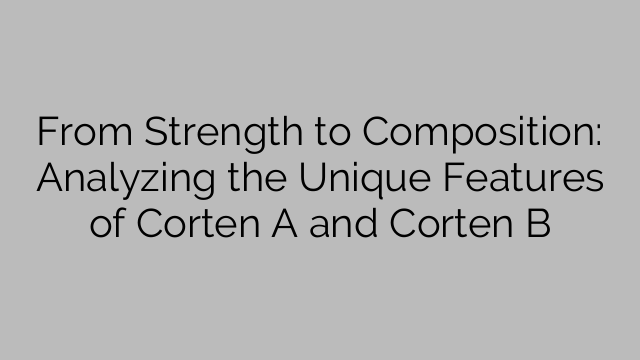In the world of construction materials, Corten steel has carved a niche for itself due to its unique properties and stunning appearance. Developed in the 1930s, Corten steel, also known as weathering steel, has become a popular choice for architects, artists, and designers looking to add an industrial touch to their creations. The two most commonly used varieties of Corten steel are Corten A and Corten B, which exhibit distinct characteristics that make them suitable for various applications.
One of the key features of Corten steel is its exceptional strength. Both Corten A and Corten B possess high tensile and yield strength, making them ideal for applications where structural durability is paramount. The steel’s ability to withstand external pressures, harsh weather conditions, and extreme temperatures is a result of its unique composition.
Corten steel is primarily composed of iron, which constitutes the bulk of the alloy, along with small amounts of copper, chromium, and nickel. The addition of copper is a defining characteristic that sets Corten steel apart from conventional steels. This alloying element acts as a catalyst for the formation of a protective layer of rust-like patina on the surface of the steel.
The patina, which develops over time, is not just aesthetically pleasing; it also serves as a natural barrier against corrosion. This self-protective mechanism is achieved through a process called “cortenizing” or “weathering.” When exposed to the elements, especially in moist conditions, Corten steel undergoes a chemical reaction that results in the formation of a stable oxide layer. This layer acts as a shield, preventing further corrosion and extending the lifespan of the steel.
While both Corten A and Corten B possess similar corrosion-resistant properties, they differ in terms of their mechanical characteristics. Corten A is known for its higher tensile strength and ultimate yield strength, making it suitable for structural applications and load-bearing structures such as bridges, buildings, and railway wagons. It is also commonly used in outdoor sculptures and artistic installations due to its rugged appearance.
On the other hand, Corten B exhibits comparable corrosion resistance but has a lower tensile strength, making it more malleable and easier to work with. This characteristic makes Corten B ideal for applications that require extensive shaping, such as architectural components, cladding, and decorative elements. It is often used in conjunction with Corten A to create striking visual effects while maintaining structural integrity.
Both Corten A and Corten B come in a range of thicknesses and sizes to suit specific project requirements. They can be supplied in structural sections, plates, sheets, or even fabricated into bespoke designs. The ability to customize the material allows architects and designers to explore endless possibilities and create unique structures that stand the test of time.
In conclusion, Corten A and Corten B offer an array of unique features that make them highly sought after in contemporary architecture and design. Their exceptional strength, corrosion resistance, and striking appearance give them an edge over conventional steels. Whether it’s for structural purposes, artistic endeavors, or decorative applications, Corten steel is a material that continues to inspire creative minds and stand as a testament to the fusion of strength and composition.
[anuncio_2]

